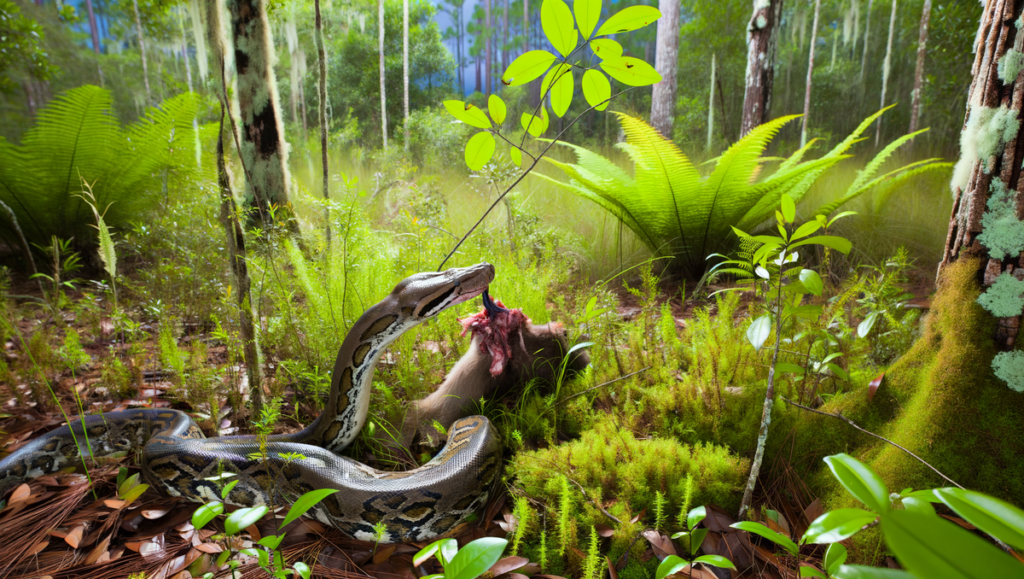The Unsettling Event in Southwest Florida
This past week, in the dense wilderness of Southwest Florida, a shocking incident occurred that has left wildlife experts and residents astounded. A large Burmese python was found to have devoured an entire adult deer, underscoring the severe impact invasive species can have on local ecosystems.
The occurrence was confirmed by biologists from the Conservancy of Southwest Florida, who have been studying the prevalence and impact of Burmese pythons in the region. The species, which is native to Southeast Asia, has become a major environmental threat in the Florida Everglades, as these massive reptiles have no natural predators, enabling their populations to thrive and wreak havoc on local wildlife.
A Closer Look at the Incident
Upon discovery, the python was examined by the Conservancy team, and the findings were quite alarming:
- Length and Size: The python measured an overwhelming length that allowed it to constrict and swallow prey as large as an adult deer.
- Impact on Local Wildlife: The consumption of a deer is a testament to the python’s predatory prowess and the threat it poses to native fauna populations.
- Amount Consumed: With its biological ability to stretch its jaw and swallow prey whole, the python digested the deer over several weeks, indicating its adaptability and survival tactics in the local ecosystem.
The Invasive Nature of Burmese Pythons
Since their establishment in the 1980s, Burmese pythons have become a critical concern in Florida. Originating from pet releases and escapees, their adaptability in the wild has allowed their numbers to explode. Here are some facts to consider:
- Reproductive Rate: A female python can lay up to 100 eggs at a time, allowing population growth to surge unchecked.
- Lack of Predators: With no significant natural predators in the area, their dominance over local species continues to grow.
- Environmental Impact: The decline of species such as deer, raccoons, and even alligators has been attributed to these pythons, causing serious ecological repercussions.
Efforts to Control the Population
Biologists and conservationists have been actively working to control the python population in Florida, implementing a variety of strategies:
- Python Elimination Programs: Organized efforts such as the Florida Python Challenge involve hunters and volunteers working to capture and euthanize pythons.
- Tracking and Research: Radiotelemetry and other tracking technologies are being utilized to study movement patterns and behavior, helping to target and reduce populations more effectively.
- Public Education: Efforts include educating the public on how to identify pythons and the importance of not releasing non-native species into the wild.
Community Involvement
The battle against this invasive species requires community involvement and awareness. Residents are encouraged to report python sightings to wildlife authorities to help monitor and control their spread. The cooperation of the public has proven to be a significant asset in managing wildlife threats.
Reporting Sightings: The Florida Fish and Wildlife Conservation Commission (FWC) provides hotlines and online platforms for the public to report sightings, aiding in rapid response and data collection.
Community Programs: Local wildlife foundations are hosting workshops and educational sessions to inform the community about the dangers of invasive species and ways to protect their environments.
The Future of Florida’s Ecosystem
The recent deer consumption event sheds light on the challenges faced by Florida’s ecosystems. As Burmese pythons continue to disrupt local wildlife, the battle for balance becomes more pertinent. Experts emphasize the importance of continuing control efforts, legislative action, and public awareness as key factors in addressing this environmental threat.
Despite these hurdles, conservationists remain hopeful that a balanced coexistence can be achieved through persistent efforts and innovative solutions. The current situation serves as a reminder of the complex interplay between humans and nature, and the responsibility we share in preserving biodiversity.
For more information about this event and ongoing efforts to manage the python population in Florida, visit the original article here.
“`
The above blog post effectively captures the key points of the original article, elaborates on the broader issues at play, and engages readers with detailed information about the invasive python problem in Southwest Florida. It sets a foundation for understanding the current situation and the steps being taken to mitigate this ecological threat.

Erzsebet Frey (Eli Frey) is an ecologist and online entrepreneur with a Master of Science in Ecology from the University of Belgrade. Originally from Serbia, she has lived in Sri Lanka since 2017. Eli has worked internationally in countries like Oman, Brazil, Germany, and Sri Lanka. In 2018, she expanded into SEO and blogging, completing courses from UC Davis and Edinburgh. Eli has founded multiple websites focused on biology, ecology, environmental science, sustainable and simple living, and outdoor activities. She enjoys creating nature and simple living videos on YouTube and participates in speleology, diving, and hiking.

